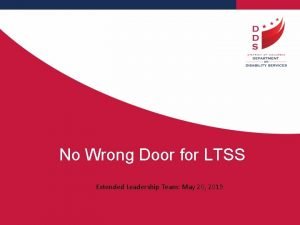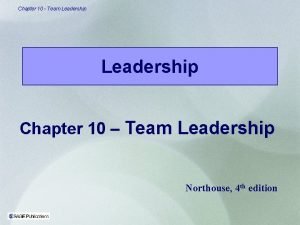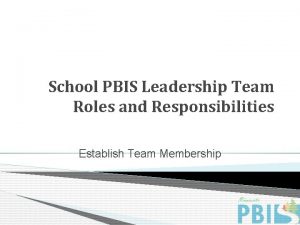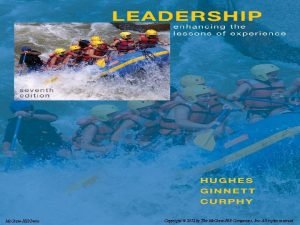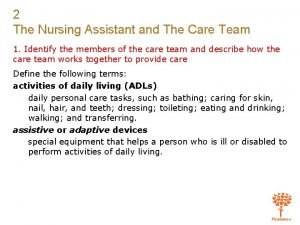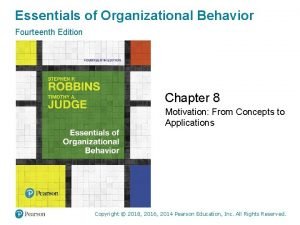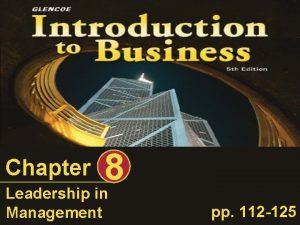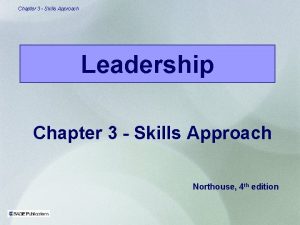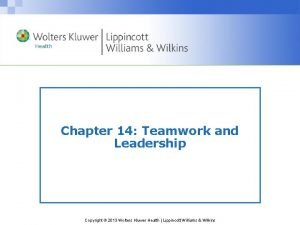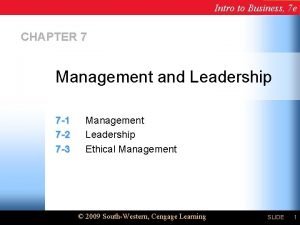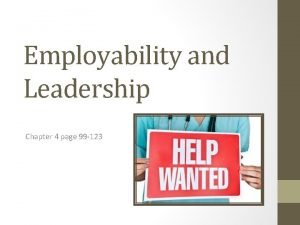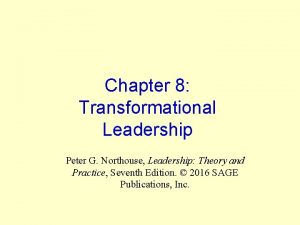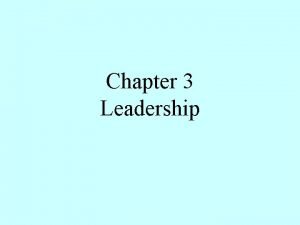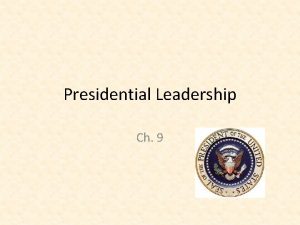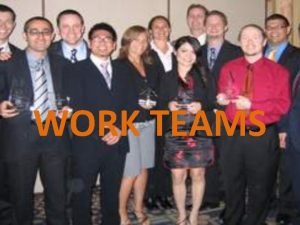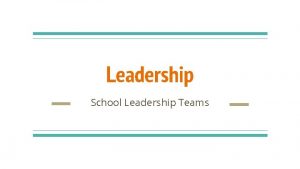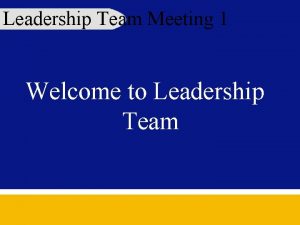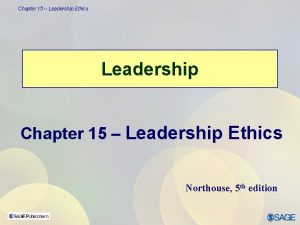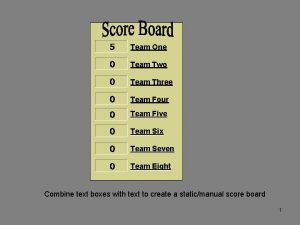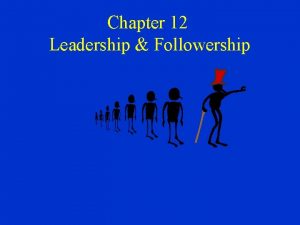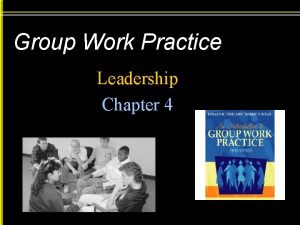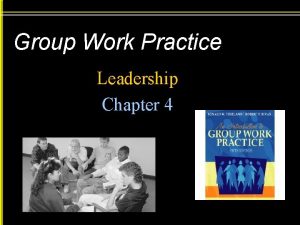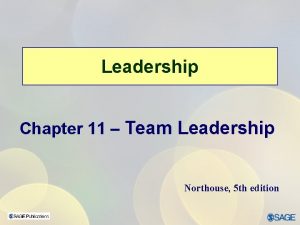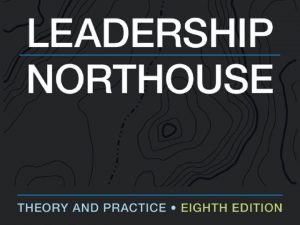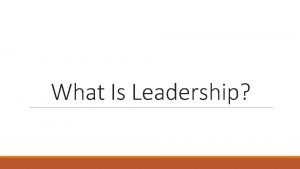Chapter 10 Team Leadership Chapter 10 Team Leadership






































- Slides: 38

Chapter 10 - Team Leadership Chapter 10 – Team Leadership Northouse, 4 th edition

Chapter 10 - Team Leadership Overview v Team Leadership Perspective v Team Leadership Model v Leadership Decisions v Leadership Actions v Team Effectiveness v Principled Leadership v. How does the Team Leadership Model Work?

Chapter 10 - Team Leadership Historical Perspective of Team Leadership – 1920 s-1980 s 20 -30 s • Human Relations movement 40 s • Group dynamics • Social • Collaborative science efforts at theory work 50 s • T group • Leader’s role in T group 60 -70 s 80 s • Organizational development • Quality • Team leader effectiveness • Benchmarking teams • Continuous improvement

Chapter 10 - Team Leadership Historical Perspective of Team Leadership – 1990 s Parker 90 s • Global 1990 perspective • Group dynamics • Flatter organizational structure • Social science theory • Strategies for • Team-based, competitive technology advantage enabled v Effectiveness research The use of teams has led to: – Greater productivity – More effective use of resources – Better decisions & problem solving – Better-quality products & services – Increased innovation & creativity

Chapter 10 - Team Leadership Description Perspective v Team research (Ilgen, Hollenbeck Johnson & Jundt, 2005) – Focus on team variables – Role of affective, behavioral & cognitive processes in team success – Team performance & viability § Role of mediating processes such as: § Trusting, bonding, planning, adapting, structuring & learning v Issues – Difficult to understand the team process because of its complexity – Leader ineffectiveness is major obstacle to overall team effectiveness

Chapter 10 - Team Leadership Description Objectives v Critical factor in success of organizational teams – understand role of leadership in teams: – Ensure team success & avoid team failure v Functions a leader must perform – Complexity involved in performing these functions – How performance of these complex functions relates to actual team performance v Team leadership capacity – – Shared or distributed leadership – Encompasses entire team

Chapter 10 - Team Leadership Model Description v Model provides leader or designated team member with a mental road map to help – Diagnose team problems, and – Take appropriate action to correct team problems v Effective team performance begins with leader’s mental model of the situation v Mental model reflects – Components of the problem – Environmental & organizational contingencies

Chapter 10 - Team Leadership Model Description v Leadership behavior – Seen as team-based problem solving v Leader uses discretion – Which problems need intervention – Make choices about which solutions are the most appropriate v Effective leaders have the ability to determine – What interventions are needed, if any, to solve team problems

Hill’s Model for Team Leadership Chapter 10 - Team Leadership

Chapter 10 - Team Leadership Decisions 1. Continue monitoring the team or take action based on current information 2. Determine the general task or relational function of intervention needed 3. Intervene at internal level (within team) or external level (team’s

Chapter 10 - Team Leadership Decision 1 Should I Monitor the Team or Take Action? v. Leaders can: – Diagnose, analyze, or forecast problems (monitoring) or take immediate action to solve a problem – Focus on problems within the group (internal) or – Which problems need intervention – Make choices about which solutions are the most appropriate v Effective leaders have the ability to determine – What interventions are needed, if any, to solve team problems

Chapter 10 - Team Leadership Decision 1 Should I Monitor the Team or Take Action? v: Mc. Grath’s critical leadership functions – two dimensions of leadership behavior: – Monitoring vs. taking action § We can diagnose, analyze, or forecast problems (monitoring) or take immediate action to solve a problem – Internal group issues vs. external group issues § Focus on the problems within the group (internal) or problems outside the group (external) v Two dimensions result in 4 types of group leadership functions

Chapter 10 - Team Leadership Decision 1

Chapter 10 - Team Leadership Decision 2 Should I Intervene to Meet Task or Relational Needs? v. Leaders can: – Determine if team needs help in dealing with relational issues or task issues – Task functions include: § Getting job done § Making decisions § Solving problems § Adapting to change § Making plans § Achieving goals

Chapter 10 - Team Leadership Decision 2 Should I Intervene to Meet Task or Relational Needs? v. Leaders can: – Determine if team needs help in dealing with relational issues or task issues – Maintenance functions include: § Developing a positive climate § solving interpersonal problems § Satisfying members’ needs § Developing cohesion

Chapter 10 - Team Leadership Decision 3 Should I Intervene Internally or Externally? v. Leader must: – Determine what level of team process needs leadership attention: – Internal task or relational team dynamics, if: § Conflict between group members § Team goals unclear – External environmental dynamics, if: § Organization not providing proper support to team

Chapter 10 - Team Leadership Actions v. Leadership Functions – performed internally or externally

Chapter 10 - Team Leadership Actions Internal Task Leadership Actions v Set of skills or actions leader might perform to improve task performance: – Goal focusing (clarifying, gaining agreement) – Structuring for results (planning, visioning, organizing, clarifying roles, delegating) – Facilitating decision making (informing, controlling, coordinating, mediating, synthesizing, issue focusing) – Training team members in task skills (educating, developing) – Maintaining standards of excellence (assessing team and individual performance, confronting inadequate performance)

Chapter 10 - Team Leadership Actions Internal Relational Leadership Actions v Set of leadership actions leader needs to implement to improve team relationships: – Coaching team members in interpersonal skills – Collaborating (including, involving) – Managing conflict and power issues (avoiding confrontation, questioning ideas)

Chapter 10 - Team Leadership Actions Internal Relational Leadership Actions v Set of leadership actions leader needs to implement to improve team relationships, cont’d. : – Building commitment and esprit de corps (being optimistic, innovating, envisioning, socializing, rewarding, recognizing) – Satisfying individual member needs (trusting, supporting, advocating) – Modeling ethical and principled practices (fair, consistent, normative)

Chapter 10 - Team Leadership Actions External Environmental Leadership Actions v Set of skills or behaviors leader needs to implement to improve environmental interface with team: – Networking and forming alliances in environment (gather information, increase influence) – Advocating and representing team to environment – Negotiating upward to secure necessary resources, support, and recognition for team

Chapter 10 - Team Leadership Actions External Environmental Leadership Actions v Set of skills or behaviors leader needs to implement to improve environmental interface with team: – Buffering team members from environmental distractions – Assessing environmental indicators of team’s effectiveness (surveys, evaluations, performance indicators) – Sharing relevant environmental information with team

Chapter 10 - Team Leadership Team Effectiveness v Team effectiveness – the desired outcome of teamwork v Team Performance – task accomplishments v Team Development – maintenance of the team v Researchers studied organizational work teams & developed – – Standard of effectiveness – Criteria of excellence

Chapter 10 - Team Leadership Team Effectiveness

Chapter 10 - Team Leadership Team Effectiveness v Clear, Elevating Goal – Clear so that one can tell if performance objective has been met – Is motivating or involving so that members believe it is worthwhile and important v Results-Driven Structure – Need to find the best structure to achieve goals § Clear team member roles § Good communication system § Methods to assess individual performance § An emphasis on fact-based judgments

Chapter 10 - Team Leadership Team Effectiveness v Competent Team Members – Components § § Right number and mix of members Members must be provided: à Sufficient information à Education and training § Requisite technical skills § Interpersonal & teamwork skills – Team Factors – Core Competencies § Openness § Ability to do the job well § Supportiveness § Problem solving ability § Action orientation § Positive personal style

Chapter 10 - Team Leadership Team Effectiveness v Unified Commitment – Teams need a carefully designed and developed sense of unity or identification (team spirit) v Collaborative Climate – Trust based on openness, honesty, consistency, and respect – Integration of individual actions – Leaders facilitate a collaborative climate by: § § Making communication safe Demanding and rewarding collaborative behavior Guiding the team’s problem-solving efforts Managing one’s own control needs

Chapter 10 - Team Leadership Team Effectiveness v Standards of Excellence – Regulated Performance § § Facilitates task completion and coordinated action Stimulates a positive pressure for members to perform at highest levels – How Accomplished § § § Requiring results (clear expectations) Reviewing results (feedback/resolve issues) Rewarding results (acknowledge superior performance)

Chapter 10 - Team Leadership Team Effectiveness v External Support and Recognition – Regulated Performance § Teams supported by external resources are: Ø Given the material resources needed to do their jobs Ø Recognized for team accomplishments Ø Rewarded by tying those rewards to team members performance, not individual achievement

Chapter 10 - Team Leadership Team Effectiveness v Principled Leadership – Influences team effectiveness through four sets of processes (Zaccaro et al. , 2001) § Cognitive - Facilitates team’s understanding of problems confronting them § Motivational - Helps team become cohesive & capable by setting high performance standards & helping team to achieve them § Affective - Assists team in handling stressful circumstances by providing clear goals, assignments, & strategies § Integrative - Helps coordinate team’s activities through matching member roles, clear performance strategies, feedback, & adapting to environmental changes

Chapter 10 - Team Leadership How Does the Team Leadership Approach Work? v Focus of Team Leadership v Strengths v Criticisms v Application

Chapter 10 - Team Leadership Focus v Model provides a cognitive map to identify group needs and offers suggestions on appropriate corrective actions v Model assists leader in making sense of the complexity of groups and provides suggested actions to improve group effectiveness

Chapter 10 - Team Leadership Focus How does the model work? v 1 st - Leader engages leader mediation process – Decides appropriate action - to monitor or take action – If team’s function satisfactory – no action – If monitoring reveals action needed – which level(s) § internal or external

Chapter 10 - Team Leadership Focus How does the model work? v 2 nd – Determining exact intervention needed – Internal relationship problem – Internal task problem – External environmental problem v 3 rd – Determine action needed or which level to intervene

Chapter 10 - Team Leadership Focus How does the model work? v 4 th – Decide to intervene at any or all 3 levels – Address the individual – internal, relational – Clarify group roles – internal, task – Negotiate of team with higher up in organization external

Chapter 10 - Team Leadership Strengths v. Provides answers to what constitutes excellent teams v. Provides a cognitive guide that assists leaders in designing and maintaining effective teams v. Recognizes the changing role of leaders and followers in organizations v. Can be used as a tool in group leader selection

Chapter 10 - Team Leadership Criticisms v Complete model has not been totally supported or tested v May not be practical as the model is complex and doesn’t provide easy answers for difficult leader decisions v Fails to provide much guidance for handling everyday interactions and complications of team management v More focus required on how to teach and provide skill development in areas of diagnosis and action taking

Chapter 10 - Team Leadership Application v. Useful in leader decision making v. Can be used as a team diagnostic tool
 Team spirit becomes team infatuation
Team spirit becomes team infatuation Team spirit becomes team infatuation
Team spirit becomes team infatuation The white team cheers for the blue team, just like
The white team cheers for the blue team, just like Extended leadership team
Extended leadership team Dau cmmc
Dau cmmc The hill model for team leadership
The hill model for team leadership School leadership team roles and responsibilities
School leadership team roles and responsibilities Ginnetts team leadership model
Ginnetts team leadership model Pbis leadership team
Pbis leadership team Transformational vs transformative leadership
Transformational vs transformative leadership Adaptive leadership vs situational leadership
Adaptive leadership vs situational leadership Enthusiastic beginner disillusioned learner
Enthusiastic beginner disillusioned learner Healthcare and the healthcare team chapter 2
Healthcare and the healthcare team chapter 2 Name the members of the dental healthcare team
Name the members of the dental healthcare team Therapeutic communication techniques
Therapeutic communication techniques Healthcare and the healthcare team chapter 2
Healthcare and the healthcare team chapter 2 5 rights of delegation nursing examples
5 rights of delegation nursing examples Chapter 2 the nursing assistant and the care team
Chapter 2 the nursing assistant and the care team Chapter 12 leadership organizational behavior
Chapter 12 leadership organizational behavior Lord of the flies chapter 8 analysis
Lord of the flies chapter 8 analysis Chapter 8 organizational leadership
Chapter 8 organizational leadership Chapter 8 leadership in management
Chapter 8 leadership in management Chapter 7 management and leadership answer key
Chapter 7 management and leadership answer key The skills approach is primarily
The skills approach is primarily Chapter 14 teamwork and leadership
Chapter 14 teamwork and leadership Chapter 12 leadership
Chapter 12 leadership Servant theory
Servant theory Leadership chapter 1
Leadership chapter 1 Intro to business chapter 7 study guide
Intro to business chapter 7 study guide Chapter 4 employability and leadership
Chapter 4 employability and leadership Chapter 4 employability and leadership
Chapter 4 employability and leadership Northouse 2016 transformational leadership
Northouse 2016 transformational leadership Transformational leadership northouse chapter 8
Transformational leadership northouse chapter 8 Leadership styles speech
Leadership styles speech Chapter 15 leadership
Chapter 15 leadership Chapter 9 presidential leadership
Chapter 9 presidential leadership Chapter 8 leadership in management
Chapter 8 leadership in management Chapter 7 management and leadership
Chapter 7 management and leadership Distinguish between group and team.
Distinguish between group and team.



